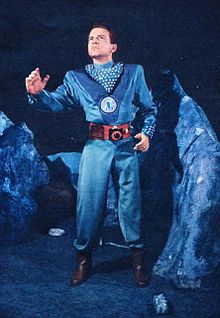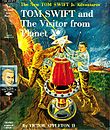Tom Corbett, Space Cadet
 Frankie Thomasas Tom Corbett in the TV-seriesTom Corbett, Space Cadet | |
| Author | Carey Rockwell |
|---|---|
| Language | English |
| Genre | Science fictionnovel |
| Publisher | Grosset & Dunlap |
Publication date | 1952 |
| Publication place | United States |
Tom Corbettis the main character in a series ofTom Corbett—Space Cadetstories that were depicted intelevision,radio,books,comic books,comic strips,and other media in the 1950s.
The stories followed the adventures of Corbett, Astro, and Roger Manning (originally; later, T.J. Thistle), cadets at the Space Academy as they train to become members of the Solar Guard. The action takes place at the Academy in classrooms andbunkrooms,aboard their training ship the rocket cruiserPolaris,and on alien worlds, both within theSolar Systemand in orbit around nearby stars.[1]
Origin[edit]
Joseph GreeneofGrosset & DunlapdevelopedTom Corbett, Space Cadet,inspired by theRobert A. HeinleinnovelSpace Cadet(1948)[2]but based on his own prior work. Greene had submitted a radio script for "Tom Ranger" and the "Space Cadets" on January 16, 1946, but it remained unperformed when Heinlein's novel was published. Greene then reworked his radio script into a script for adaily newspaper adventure strip,which was never produced.
Television[edit]
The character appeared in the TV-seriesTom Corbett, Space Cadet(1950–1955).
In other media[edit]
Books[edit]
The books from 1952–1956 were published byGrosset & Dunlap,written by unknown authors under the pseudonym Carey Rockwell, with Willy Ley as technical advisor.
- Stand By For Mars(1952)
- Danger in Deep Space(1953)
- On the Trail of the Space Pirates(1953)
- The Space Pioneers(1953)
- The Revolt on Venus(1954)
- Treachery in Outer Space(1954)
- Sabotage in Space(1955)
- The Robot Rocket(1956)
In 1953 a slim children's book titledTom Corbett's Wonder Book of Space(orTom Corbett: A Trip to the Moon) was written by Marcia Martin and published by Wonder Books.
Comic strip[edit]
TheTom Corbett — Space Cadetcomic strip,drawn inMilton Caniffstyle by Ray Bailey, ran Sunday and daily in American newspapers, from September 9, 1951 to September 6, 1953.Paul S. Newmanscripted through February 8, 1953. The strips from September 9, 1951 to July 31, 1952 were republished by Eternity Comics as five issues ofThe Original Tom Corbett, Space Cadet.
Comic books[edit]
The original Tom Corbett series was published byDell Comicsbeginning in theirFour Colorseries, which was used to try out new story lines on the public to obtain feedback. After three tryout issues, Corbett moved to a standalone title which began numbering at #4.[3]Corbett was also featured in a 1953 issue ofBoys and GirlsMarch of Comics,published by the K.K. Publications imprint ofWestern Publishing,with which Dell was partnered. As the popularity of the television series waned, Dell stopped producing the comic book at #11 in 1954, and the series was taken up in 1955 byPrize Comicsfor three issues. All eleven Dell issues were reprinted in black and white by the UK basedWorld Distributors,with some cover rearrangements and material omissions. The Dell standalone issues were re-released digitally—albeit not in publication order—byBluewater ComicsasTom Corbett: Space Cadet Classicsin 2014–2015. In 2017, PS Artbooks released two volumes as part of their "Pre-Code Classics" line, collecting the first seven Dell issues in volume one, and the remaining four Dell issues along with the three Prize issues in volume two.
There were two four-issue manga-styleTom Corbett, Space Cadetmini-series released byEternity Comicsin the 1990, eventually followed by two four-issueTom Corbett: Space Cadetmini-series released by Bluewater Comics in 2009 and 2012–2013.
|
Dell Comics(February 1952–September–November 1954)
K.K. Publications
World Distributors
Prize Comics(May 1955–October 1955)
Eternity Comics 1990
Bluewater Comics
PS Artbooks
|
Radio[edit]
The cast for the radio program was the same as for the television series. It ran from January 1-June 26, 1952, as a half-hour show twice a week,[5]on Tuesday and Thursday. Each story line would start on Tuesday and end on Thursday.[6]Many of the radio episodes were based on television episodes. A radio version produced in Australia used local actors.[citation needed]
The radio drama company The Colonial Radio Theatre on the Air produced two "radio dramatization" audio versions of BlueWater/Tidalwave titles,Tom Corbett Space Cadet(2012), andTom Corbett Space Cadet: Danger in Deep Space(2013).
Music[edit]
There was also a musical recording, "Tom Corbett, Space Cadet, Song and March" in 1951 ( "Space Cadet Song” b/w an instrumental version called "Space Cadet March" ). These were performed by the “Space Cadet Marching Band and Chorus” (in reality, studio musicians directed by Columbia Records executiveMitch Miller) and released on Simon & Schuster’s Golden Records kiddie label.[7][8]
Toys and tie-ins[edit]
There was aTom Corbett—Space CadetView-Masterpacket containing three reels. Its three-dimensional photographs were brilliantly colored but were taken of sculptures of the characters and models of the spacecraft and props. The story was of finding on the moon a miniature pyramid made by unknown aliens, which led to a clue on Mars, and finally to fighting interplanetary crooks in the asteroid belt.
There were also several coloring books; a flashlight; a punch-out book; a costume for children; a lunch box; a pocket watch; a Space Academyplaysetwith plastic figures; a set of rubber molds for making plaster-of-Paris figures, furniture and vehicles, made by Marx toys; a Little Golden Book; and a Little Golden Record of the Space Academy song ( "From the rocket fields of the academy / to the far flung stars of outer space / we are space cadets training to be / ready for dangers we may face" ). Two other records presentedSpace Cadetadventures, starring the original TV/radio cast: "Tom Corbett Space Cadet at Space Academy" and "Rescue in Space: Tom Corbett, Space Cadet".
The back of boxes of Kellogg'sPep Cerealfeatured cardboard cutouts of a space cadet cap, gauntlets, and a ray gun, and the cereal company made a direct tie-in with the product Kellogg's Pep: The Solar Cereal. Kellogg also published a "Tom Corbett Space Cadet News", Vol. 1 #1, a 23x15 inch newspaper, folded in half, 4 pages.
The show was the subject of a parody, "Lawrence Fechtenberger, Interstellar Officer Candidate", a serial that made several appearances on programs ofBob and Ray.
References[edit]
- ^Woolery, George W. (1985).Children's Television: The First Thirty-Five Years, 1946-1981, Part II: Live, Film, and Tape Series.The Scarecrow Press. pp. 516–520.ISBN0-8108-1651-2.
- ^"The roots of Tom Corbett in SPACE CADET was confirmed by the Heinleins in 1977 and by other written sources since that time. When a comparison of the Tom Corbett series published by Grosset & Dunlap (now out of print) and Heinlein'sSpace Cadet,the similarities become apparent ".Robert Heinlein's Influence on Tom Corbett
- ^Schelly, William (2013).American Comic Book Chronicles: The 1950s.TwoMorrows Publishing. p. 50.ISBN9781605490540.
- ^Preview of Tom Corbett: Space Cadet #1 (2009) by Bluewater ProductionsArchived2009-09-13 at theWayback Machine
- ^"RadioEchoes.com".
- ^"Solar Guard Academy".Retrieved28 March2017.
- ^"Tom Corbett Space Cadet: Toys",Billy Ireland Cartoon Library & Museum, The Ohio State University Libraries.ArchivedSeptember 28, 2011, at theWayback Machine
- ^"Tom Corbett Space Cadet Song and March",item onEtsy.com.Songs and records were (c) Rockhill Radio Inc. Made in the US by The Sandpiper Press, distributed by Simon & Schuster.
Bibliography[edit]
- David Weinstein,The Forgotten Network: DuMont and the Birth of American Television(Philadelphia:Temple University Press,2004)ISBN1-59213-245-6
- Alex McNeil,Total Television,Fourth edition (New York:Penguin Books,1980)ISBN0-14-024916-8
- Tim Brooks and Earle Marsh,The Complete Directory to Prime Time Network TV Shows,Third edition (New York:Ballantine Books,1964)ISBN0-345-31864-1
External links[edit]
- The Solar Guard Website
- The Solar Guard: The Tom Corbett Page(information about the books)
- Stand By for MarsatStandard Ebooks
- Works by Carey RockwellatProject Gutenberg
- Tom Corbett, Space Cadetseries listing at theInternet Speculative Fiction Database
- Tom Corbettat seriesbooks.info
- Works by or about Carey RockwellatInternet Archive
- Works by or about Tom CorbettatInternet Archive
- Works by Carey RockwellatLibriVox(public domain audiobooks)

- Listen to episodes of theTom Corbett, Space Cadetradio program
- Frankie Thomas Tribute atThe Thunder Childweb magazine
- "The Original Space Cadet" by Frank Kuznik,Air and Space,April-May 1995
- Details and Cover Gallery of the DellTom Corbetseries
- Tom Corbett Space Cadet at Old Time Radio Outlaws
- Illustrations from the 1950s book series
- 1951 comics debuts
- 1953 comics endings
- 1952 comics debuts
- 1954 comics endings
- 1955 comics debuts
- 1955 comics endings
- 1990 comics debuts
- 1990 comics endings
- Book series introduced in 1952
- American children's science fiction television series
- Fiction about the Solar System
- Novel series
- Fictional military captains
- Television series set in the future
- Fictional characters from the 24th century
- Grosset & Dunlap books
- Fictional astronauts
- 1950 American television series debuts
- 1955 American television series endings
- 1950s American science fiction television series
- CBS original programming
- American Broadcasting Company original programming
- NBC original programming
- DuMont Television Network original programming
- 1950s American radio programs
- Space adventure television series
- Black-and-white American television shows
- American English-language television shows
- ABC radio programs
- 1952 radio programme debuts
- 1952 radio programme endings
- American radio dramas
- American science fiction radio programs
- Aviation radio series
- Radio programs based on comic strips
- Dell Comics titles

